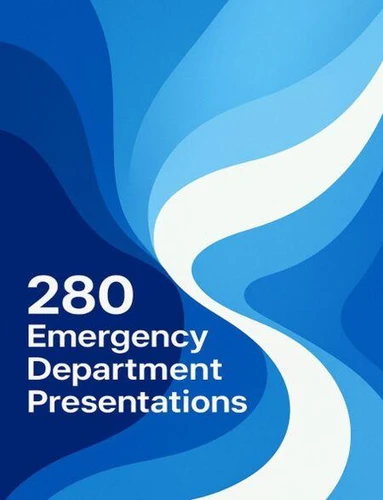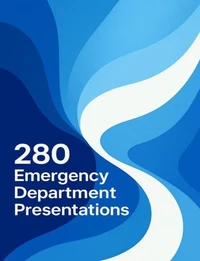- Accueil /
- Hatem Raad
Hatem Raad

Dernière sortie
280 Emergency Department Presentations
"280 Emergency Department Presentations: Quick-Reference Pocket Guide" was created to meet the urgent needs of frontline clinicians who require clear, concise information exactly when they need it. Drawing on thousands of real-world cases and feedback from residents, attending physicians, paramedics, and nurses, this guide distills the most common scenarios into a single, easy-to-navigate resource.
Purpose & Scope Rapid Retrieval: Organized into 14 organ-system chapters, each entry is indexed and laid out uniformly so you can jump straight to the topic under pressure. Focused Content: Each of the 280 presentations highlights only the "must-know" elements-key identifiers and critical numbers-without lengthy background detail. Key Features System-Based Organization: Navigate by Cardiovascular, Pulmonary, Neurologic, Gastrointestinal, Genitourinary & OB/GYN, Musculoskeletal & Soft Tissue, Dermatologic, Hematologic & Oncologic, Endocrine & Metabolic, Psychiatric, Toxicologic & Poisoning, Trauma & Environmental, ENT & Head & Neck, and Ophthalmologic presentations.
Uniform Entry Layout: Every presentation follows the same structure-title, essential highlights, and page reference-minimizing cognitive load. Critical One-Page Tables: Includes vital-sign norms, laboratory ranges, common scoring systems (e.g., GCS, APGAR, RTS), and medication-conversion charts so you have immediate access to lifesaving numbers. Expert-Reviewed: Content has been vetted by experienced emergency-medicine clinicians to ensure relevance and accuracy.
Who Should Use It Residents & Medical Students seeking a high-yield companion between shifts and study sessions. Attending Physicians & Physician Assistants wanting a reliable safety net during consults on less-familiar cases. Paramedics, Nurses & Allied Health Professionals needing a field-ready reference for core emergency scenarios.
Purpose & Scope Rapid Retrieval: Organized into 14 organ-system chapters, each entry is indexed and laid out uniformly so you can jump straight to the topic under pressure. Focused Content: Each of the 280 presentations highlights only the "must-know" elements-key identifiers and critical numbers-without lengthy background detail. Key Features System-Based Organization: Navigate by Cardiovascular, Pulmonary, Neurologic, Gastrointestinal, Genitourinary & OB/GYN, Musculoskeletal & Soft Tissue, Dermatologic, Hematologic & Oncologic, Endocrine & Metabolic, Psychiatric, Toxicologic & Poisoning, Trauma & Environmental, ENT & Head & Neck, and Ophthalmologic presentations.
Uniform Entry Layout: Every presentation follows the same structure-title, essential highlights, and page reference-minimizing cognitive load. Critical One-Page Tables: Includes vital-sign norms, laboratory ranges, common scoring systems (e.g., GCS, APGAR, RTS), and medication-conversion charts so you have immediate access to lifesaving numbers. Expert-Reviewed: Content has been vetted by experienced emergency-medicine clinicians to ensure relevance and accuracy.
Who Should Use It Residents & Medical Students seeking a high-yield companion between shifts and study sessions. Attending Physicians & Physician Assistants wanting a reliable safety net during consults on less-familiar cases. Paramedics, Nurses & Allied Health Professionals needing a field-ready reference for core emergency scenarios.
"280 Emergency Department Presentations: Quick-Reference Pocket Guide" was created to meet the urgent needs of frontline clinicians who require clear, concise information exactly when they need it. Drawing on thousands of real-world cases and feedback from residents, attending physicians, paramedics, and nurses, this guide distills the most common scenarios into a single, easy-to-navigate resource.
Purpose & Scope Rapid Retrieval: Organized into 14 organ-system chapters, each entry is indexed and laid out uniformly so you can jump straight to the topic under pressure. Focused Content: Each of the 280 presentations highlights only the "must-know" elements-key identifiers and critical numbers-without lengthy background detail. Key Features System-Based Organization: Navigate by Cardiovascular, Pulmonary, Neurologic, Gastrointestinal, Genitourinary & OB/GYN, Musculoskeletal & Soft Tissue, Dermatologic, Hematologic & Oncologic, Endocrine & Metabolic, Psychiatric, Toxicologic & Poisoning, Trauma & Environmental, ENT & Head & Neck, and Ophthalmologic presentations.
Uniform Entry Layout: Every presentation follows the same structure-title, essential highlights, and page reference-minimizing cognitive load. Critical One-Page Tables: Includes vital-sign norms, laboratory ranges, common scoring systems (e.g., GCS, APGAR, RTS), and medication-conversion charts so you have immediate access to lifesaving numbers. Expert-Reviewed: Content has been vetted by experienced emergency-medicine clinicians to ensure relevance and accuracy.
Who Should Use It Residents & Medical Students seeking a high-yield companion between shifts and study sessions. Attending Physicians & Physician Assistants wanting a reliable safety net during consults on less-familiar cases. Paramedics, Nurses & Allied Health Professionals needing a field-ready reference for core emergency scenarios.
Purpose & Scope Rapid Retrieval: Organized into 14 organ-system chapters, each entry is indexed and laid out uniformly so you can jump straight to the topic under pressure. Focused Content: Each of the 280 presentations highlights only the "must-know" elements-key identifiers and critical numbers-without lengthy background detail. Key Features System-Based Organization: Navigate by Cardiovascular, Pulmonary, Neurologic, Gastrointestinal, Genitourinary & OB/GYN, Musculoskeletal & Soft Tissue, Dermatologic, Hematologic & Oncologic, Endocrine & Metabolic, Psychiatric, Toxicologic & Poisoning, Trauma & Environmental, ENT & Head & Neck, and Ophthalmologic presentations.
Uniform Entry Layout: Every presentation follows the same structure-title, essential highlights, and page reference-minimizing cognitive load. Critical One-Page Tables: Includes vital-sign norms, laboratory ranges, common scoring systems (e.g., GCS, APGAR, RTS), and medication-conversion charts so you have immediate access to lifesaving numbers. Expert-Reviewed: Content has been vetted by experienced emergency-medicine clinicians to ensure relevance and accuracy.
Who Should Use It Residents & Medical Students seeking a high-yield companion between shifts and study sessions. Attending Physicians & Physician Assistants wanting a reliable safety net during consults on less-familiar cases. Paramedics, Nurses & Allied Health Professionals needing a field-ready reference for core emergency scenarios.
